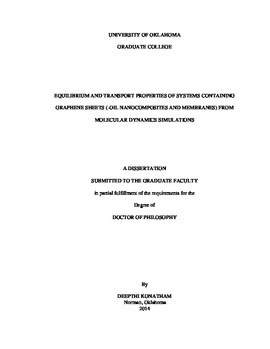| dc.contributor.advisor | Grady, Brian P | |
| dc.contributor.advisor | Striolo, Alberto | |
| dc.contributor.author | Konatham, Deepthi | |
| dc.date.accessioned | 2014-12-12T15:17:13Z | |
| dc.date.available | 2014-12-12T15:17:13Z | |
| dc.date.issued | 2014-12-12 | |
| dc.identifier.uri | https://hdl.handle.net/11244/13876 | |
| dc.description.abstract | Graphene sheets belong to an interesting class of materials. Their exceptional properties, including high thermal and electrical conductivity, mechanical strength etc., could play an important role in multiple applications, suggesting the possible use of graphene sheets in, e.g., electronic devices, nanocomposites, energy storage, and membranes for water desalination, to name just a few. Understanding the properties of graphene is essential to secure progress in all these areas. Molecular dynamics simulations were performed to provide molecular level insights of the equilibrium and transport properties of several systems containing graphene sheets. | en_US |
| dc.description.abstract | In the first part of the thesis graphene-oil nanocomposites are considered. Results show that it is possible to obtain stable dispersions of graphene sheets in oils such as n-hexane, n-octane and n-dodecane by appropriately functionalizing the edges of the graphene sheets with short branched alkanes. Excluded-volume effects, generated by the branched architecture of the functional groups grafted on the graphene sheets, are responsible for the stabilization of small graphene sheets in the organic systems considered here. Using non-equilibrium molecular dynamics, the Kapitza resistance at the graphene-octane and graphene-graphene interfaces was calculated. Our results demonstrate that it is possible to reduce the Kapitza resistance at the graphene sheet-octane interface by using the functionalized graphene sheets, but the functional groups must show vibrational modes compatible with those of the organic matrix. A higher value of Kapitza resistance for graphene sheets in vacuum compared to that in octane was found because the graphene-graphene interface has larger Kapitza resistance than the graphene-octane interface, which is consistent with observations for carbon nanotube – carbon nanotube contacts. More importantly, the Kapitza resistance for the graphene-graphene contact can be 30% lower than values reported for the carbon nanotube – carbon nanotube contact. Equilibrium and non-equilibrium molecular dynamics simulations to assess the effective interactions between dispersed graphene sheets, the self-assembly of graphene, and the heat transfer through the graphene-octane nanocomposite. Evidence is provided for the formation of nematic phases when the graphene sheets volume fraction increases within octane. The atomic-level results are input for a coarse-grained Monte Carlo simulation that predicts anisotropic thermal conductivity for graphene-based composites when the graphene sheets show nematic phases. Overall, these results suggest that it might be possible to produce nanocomposites containing graphene sheets. Such materials could show exceptional mechanical and thermal-transport properties (due to the inclusion of graphene sheets), while maintaining the lightweight typical of polymeric materials. | |
| dc.description.abstract | In the second part of the thesis umbrella sampling simulations were employed to study the transport of water molecules and ions through the membranes incorporating bare and functionalized graphene pores. By calculating the potential of mean force for ion and water translocation through the bare graphene pores, we show that ions face a large energy barrier and will not pass through the narrower pore studied (Ø ~ 7.5 Å) but can pass through the wider pores (Ø ~ 10.5 and 14.5). Water, however, faces no such impediment and passes through all the pores studied with little energy barrier. When charged groups are grafted to the pore rim, the results show that the charges can help to prevent the passage of ions. Comparison of results for graphene pore to that of carbon nanotube pore reveals that COO- groups are more effective when grafted to the rim of GS pore in preventing Cl- ions from passing through the membrane compared to that of carbon nanotube pore. The results presented could be useful for the design of water desalination membranes. | |
| dc.language | en_US | en_US |
| dc.subject | graphene, molecular dynamics | en_US |
| dc.title | Equilibrium and Transport Properties of Systems Containing Graphene Sheets (-Oil Nanocomposites and Membranes) from Molecular Dynamics Simulations | en_US |
| dc.contributor.committeeMember | Papavassiliou, Dimitrios V | |
| dc.contributor.committeeMember | Huang, Liangliang | |
| dc.contributor.committeeMember | Mullen, Kieran | |
| dc.contributor.committeeMember | Hawa, Takumi | |
| dc.date.manuscript | 2014-12-09 | |
| dc.thesis.degree | Ph.D. | en_US |
| ou.group | College of Engineering::School of Chemical, Biological and Materials Engineering | en_US |
